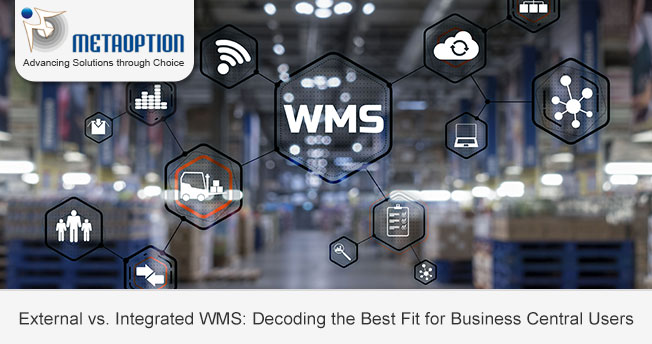
When comparing External WMS (Warehouse Management System) and Integrated WMS (specifically integrated into Microsoft Dynamics 365 Business Central), the choice between them hinges on various factors such as functionality, cost, complexity, and integration requirements. Here’s an in-depth comparison of the two:
1. Functionality
External WMS:
- Advanced Features: Typically offers more specialized and advanced warehouse functionalities (e.g., automation, advanced reporting, RFID, and sophisticated picking algorithms).
- Industry Specificity: This may include industry-specific capabilities for sectors like retail, manufacturing, or logistics.
- Flexibility: Often allows customization to meet specific warehouse processes.
Integrated WMS in Business Central:
- Basic to Moderate Features: This usually covers essential warehousing functionalities (e.g., inventory management, basic picking and packing, and order tracking).
- Out-of-the-Box Integration: Seamlessly integrates with Business Central modules like finance, sales, and purchasing.
- Simplicity: Ideal for businesses that need straightforward warehousing without complex requirements.
2. Integration and Connectivity
External WMS:
- Complex Integration: Requires third-party connectors or APIs to sync with Business Central, which can introduce integration challenges and require ongoing maintenance.
- Data Silos Risk: Potential for data silos if not properly integrated, leading to delays or discrepancies in data synchronization.
- Scalability: Can connect to multiple ERP systems if necessary, useful for businesses using more than one ERP solution.
Integrated WMS in Business Central:
- Native Integration: Provides seamless data flow between WMS and other Business Central modules (finance, sales, etc.), reducing integration complexities.
- Unified Platform: Ensures consistent data across the entire system with minimal integration overhead.
- Lower Maintenance: Fewer points of failure and reduced IT overhead compared to managing a separate system.
3. Cost
External WMS:
- Higher Initial Costs: Generally requires a higher initial investment for purchase, integration, and potential customization.
- Ongoing Costs: This may incur additional costs for licenses, maintenance, support, and integration management.
- Long-Term ROI: Potentially higher return on investment for businesses needing advanced WMS capabilities.
Integrated WMS in Business Central:
- Lower Initial Costs: Typically involves lower initial costs, leveraging existing Business Central licenses.
- Unified Costs: Costs are consolidated within the Business Central environment, simplifying budgeting.
- Cost-Effective for Simple Needs: More economical for businesses with basic warehousing needs.
4. Complexity and Implementation
External WMS:
- Implementation Complexity: Often requires a more complex implementation process involving detailed configuration, testing, and user training.
- Customization Needs: This may require significant customization to align with business processes.
- Longer Timeline: Implementation and integration can take longer due to the complexity of syncing with existing systems.
Integrated WMS in Business Central:
- Simpler Implementation: Typically faster to deploy as it aligns with Business Central’s framework.
- Ease of Use: Designed to be user-friendly for those already familiar with Business Central.
- Streamlined Process: Less complex and more straightforward for businesses already using Business Central.
5. Support and Maintenance
External WMS:
- Vendor Support: Relies on external vendors for support, which can sometimes lead to delays in issue resolution.
- Specialized Expertise: This may require specialized knowledge for maintenance and troubleshooting.
- Separate Upgrades: Upgrade cycles may not align with Business Central, leading to potential integration challenges.
Integrated WMS in Business Central:
- Single Vendor Support: Easier support as issues are handled within the Business Central ecosystem.
- Unified Maintenance: Updates and maintenance are managed within Business Central, ensuring compatibility.
- Simplified Upgrades: Aligns with Business Central upgrade cycles, minimizing disruption.
6. Scalability and Future Needs
External WMS:
- High Scalability: Often more scalable for large or rapidly growing businesses needing complex warehousing solutions.
- Future Proofing: Provides extensive features and can adapt to evolving warehousing needs.
Integrated WMS in Business Central:
- Moderate Scalability: Sufficient for small to medium-sized businesses with simpler warehousing needs.
- Growth Potential: Suitable for businesses that expect stable growth without a drastic increase in warehousing complexity.
Choosing the Right Option
External WMS might be the right choice if:
- You have complex warehousing needs requiring advanced features.
- Your business operates in an industry with specific WMS requirements.
- You are prepared to manage integration and potentially higher costs.
Integrated WMS in Business Central might be suitable if:
- You need a cost-effective, simpler solution for basic to moderate warehousing needs.
- You prefer seamless integration with existing Business Central functionalities.
- Your business values ease of use and lower maintenance overhead.
Summary Table
| Aspect | External WMS | Integrated WMS in Business Central |
|---|---|---|
| Functionality | Advanced, specialized | Basic to moderate, general |
| Integration | Complex, potential data silos | Seamless, unified data |
| Cost | Higher initial and ongoing costs | Lower initial and ongoing costs |
| Implementation | Complex, longer timeline | Simple, faster deployment |
| Support | External vendor, specialized | Unified within Business Central |
| Scalability | Highly scalable for complex needs | Moderately scalable, simpler needs |
Choosing MetaWMS involves evaluating your specific warehousing requirements, budget, and how critical seamless integration with your ERP system is.
For more information and a tailored demonstration contact us today at Metaoption.


